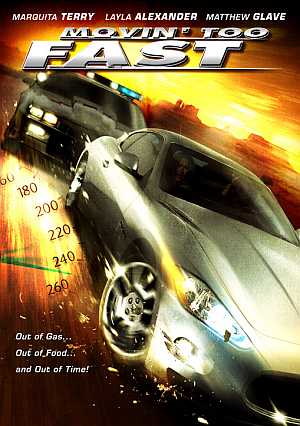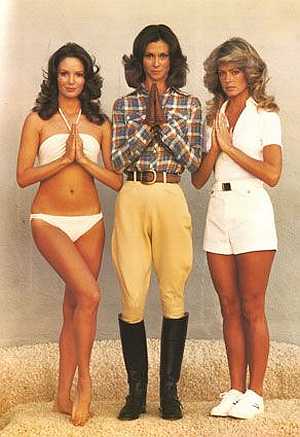★★★★
“Proves that action heroines come in all shapes and sizes.”

 With somewhere north of two hundred cable channels to surf through, a show has about ten seconds to grab our attention. When we spotted Ninja Warrior on G4 Tech TV, I thought it would probably be one of those anime series. I couldn’t be more wrong. It’s actually a sports entertainment series from Japan, where competitors go through four assault-course type stages, of increasing toughness. It’s pretty brutal; in the decade the show has been on the air, only two of the 1,800 entrants have made it all the way to the end. However, it’s presence here is due to the spin-off for female competitors, which is being broadcast, also on G4, as Women of Ninja Warrior; the Japanese title Kunoichi translates, more or less, as “female ninja.”
With somewhere north of two hundred cable channels to surf through, a show has about ten seconds to grab our attention. When we spotted Ninja Warrior on G4 Tech TV, I thought it would probably be one of those anime series. I couldn’t be more wrong. It’s actually a sports entertainment series from Japan, where competitors go through four assault-course type stages, of increasing toughness. It’s pretty brutal; in the decade the show has been on the air, only two of the 1,800 entrants have made it all the way to the end. However, it’s presence here is due to the spin-off for female competitors, which is being broadcast, also on G4, as Women of Ninja Warrior; the Japanese title Kunoichi translates, more or less, as “female ninja.”
It’s gone through six tournaments since its 2002 debut. Most participants in WoNW are Japanese, obviously, but Kyra Gracie, member of the famous Brazilian fighting family, plus Romanian Olympic gymnasts Catalina Ponor and Oana Ban, have also entered – with mixed results, shall we say! It plays almost like a straight-faced version of MXC. The original Japanese commentary is sub-titled, albeit badly: even non-speakers can tell it’s often out of synch or poorly-translated, and sometimes reveals the fate of a contestant before it happens. The vast majority clearly take it seriously – though perhaps not quite as seriously as the men, where it appears half the contestants have built replicas of the obstacles in their back-yards, in their quest for glory.
 The tests here, however, are aimed more at agility than strength, such as Domino Hill (top, right) a precarious test of balance on increasingly-unstable block. They certainly remain extremely challenging: the first tournament was so brutal, that only two competitors made it past stage one, and neither survived the first obstacle on stage two. Only one woman has ever completed the course, the “Queen of Ninja Warrior”, G-Rockets dancer Ayako Miyake, and she has done it an incredible three times, despite adjustments made after each tournament. That’s hasn’t stopped Miyake, who has whizzed up the final stage (bottom, left) without apparent problem, netting her the grand prize of two million yen (about $20,000) per show, and making the tiny (5’2″, 90-pound!) dancer something of a celebrity. She’d be great as Kei if they ever did a live-action version of Dirty Pair Flash.
The tests here, however, are aimed more at agility than strength, such as Domino Hill (top, right) a precarious test of balance on increasingly-unstable block. They certainly remain extremely challenging: the first tournament was so brutal, that only two competitors made it past stage one, and neither survived the first obstacle on stage two. Only one woman has ever completed the course, the “Queen of Ninja Warrior”, G-Rockets dancer Ayako Miyake, and she has done it an incredible three times, despite adjustments made after each tournament. That’s hasn’t stopped Miyake, who has whizzed up the final stage (bottom, left) without apparent problem, netting her the grand prize of two million yen (about $20,000) per show, and making the tiny (5’2″, 90-pound!) dancer something of a celebrity. She’d be great as Kei if they ever did a live-action version of Dirty Pair Flash.
As a show, it is simply phenomenally watchable, especially for such a simple concept. You just get sucked in, cheering the competitors on as they give their all, struggling against the fiendish contraptions to avoid being dumped into the icy waters at Mt. Midoriyama – literally, as the contests often take place in December, with the second enduring snowy outbursts! It’s such genuine emotion and exertion on view. Okay, some of the wipeouts are spectacular, in a “F___ me! Rewind that!” kinda way, but while that may lure you in initially, you eventually find yourself rooting for them not to fail, which is where it differs from MXC. High-fives were exchanged when Miyake cleared stage four for the first time, and we realised that we actually cared. Few TV shows – and even fewer “reality” ones – have ever had that effect on us.





 Yes, while there may not be a lot new here, the combination is at least somewhat interesting, and it’s put together solidly enough. Two students, Nina (Alexander) and Melissa (Terry) are on a cross-country drive, when they get stopped for speeding. Melissa makes a pass at the cop, but it’s an encounter that goes badly wrong, and she ends up beating him up with his own night-stick. When the duo get back on the road however, they find themselves being pursued by a police-car, which clearly has very bad intentions: with gas running low and – inevitably – no cellphone service to be found, can they survive?
Yes, while there may not be a lot new here, the combination is at least somewhat interesting, and it’s put together solidly enough. Two students, Nina (Alexander) and Melissa (Terry) are on a cross-country drive, when they get stopped for speeding. Melissa makes a pass at the cop, but it’s an encounter that goes badly wrong, and she ends up beating him up with his own night-stick. When the duo get back on the road however, they find themselves being pursued by a police-car, which clearly has very bad intentions: with gas running low and – inevitably – no cellphone service to be found, can they survive? I suppose my main surprise is how pedestrian this was. Action? Hardly anything to speak of at all, despite the credit sequence which shows them training as police officers. The story has them going undercover at a vineyard, whose owner vanished seven years ago, and is about to be declared legally-dead: his ex-wife (Muldaur) and the sleazy foreman will clean up…unless the daughter, also missing, shows up. Of course, the Angels play both a fake daughter (Smith) and the ‘real’ thing (Jackson) – the former is designed to be exposed, in order to get herself involved with the wife and foreman, and reveal what’s going on. Quite cunning, really.
I suppose my main surprise is how pedestrian this was. Action? Hardly anything to speak of at all, despite the credit sequence which shows them training as police officers. The story has them going undercover at a vineyard, whose owner vanished seven years ago, and is about to be declared legally-dead: his ex-wife (Muldaur) and the sleazy foreman will clean up…unless the daughter, also missing, shows up. Of course, the Angels play both a fake daughter (Smith) and the ‘real’ thing (Jackson) – the former is designed to be exposed, in order to get herself involved with the wife and foreman, and reveal what’s going on. Quite cunning, really.